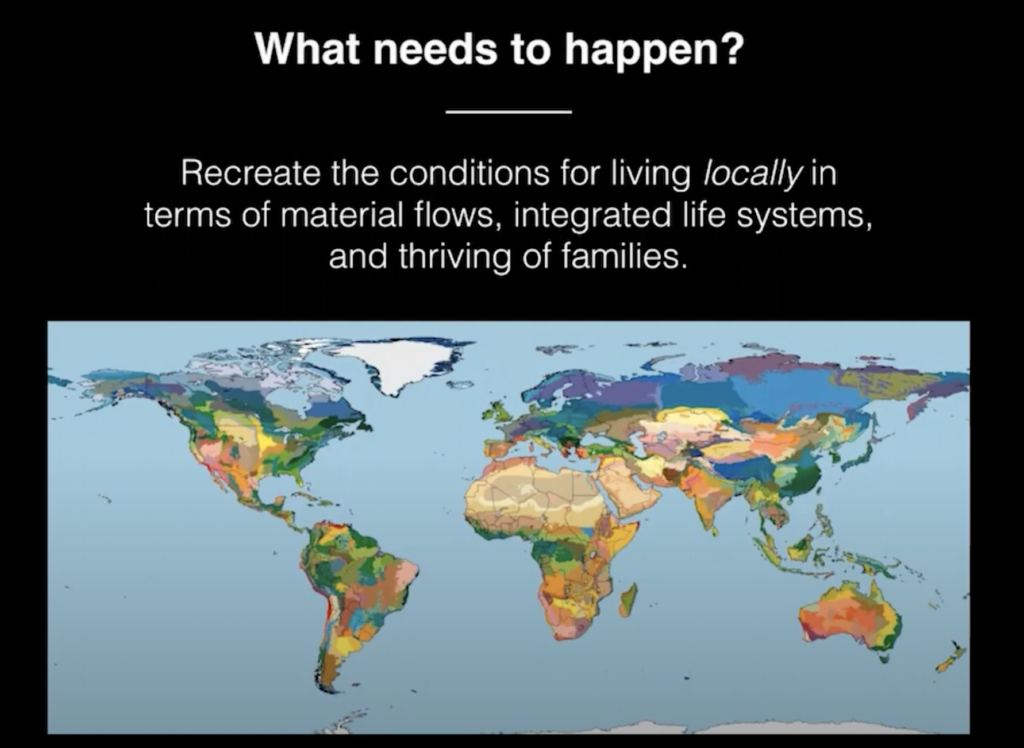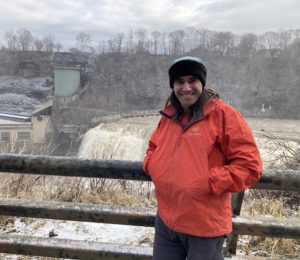Rochester’s Bioregional Future

Great Lakes Sub-Basins (Wikipedia)
A Turning Point?
A recap of recent events — for those who were there, and those who weren’t
The Emergence of Bioregional Activation
Further to Joe and Penny’s whirlwind visit to the Great Lakes Basin Bioregion — Toronto, Cleveland, and Rochester were all major stops (between January 30 and February 12) — we’re seeing the emergence of a new level of interest in “bioregionalism,” in the sense of “a philosophy that suggests that political, cultural, and economic systems are more sustainable and just if they are organized around naturally defined areas called bioregions, similar to ecoregions.” (Wikipedia). In truth, it is not just a philosophy that things might be better this way; it’s also a recipe for taking practical action to restore the health and vitality of our bioregions. (This is the “activation” part.)

Joe Brewer at the Lower Falls
Joe Brewer’s visit to Rochester included a winter field trip along the Genesee from the High Falls to Lake Ontario on Saturday, February 11, 2023. Here he is at the Lower Falls.
A Turning Point?
We’ll know in a few years if Joe & Penny’s visit to the Great Lakes Basin was a turning point in the emergence of a new bioregional emphasis in the Great Lakes Basin and in the Rochester area. Of course, many transformative events come and go in our lives, and few go on to really change the trajectory we’re on. This one has the potential to do so, if we recognize it as opening up a new realm of possibility. Joe Brewer’s Design Pathway for Regenerating Earth (2021) provides the “cultural scaffolding” we need to recognize the importance of creating a global network of bioregional learning centers—think and do centers, ecoversities, and bioregional councils that can learn and evolve together to create a regenerated Earth.
To view Joe’s Rochester talks, see
https://youtu.be/W1eA75yjGiE (Friday at Greentopia), and
https://youtu.be/wHDcsyMfTp0 (Saturday at Rundel Memorial Public Library)
We’re currently hosting two Zoom calls on alternating weeks, one for the Great Lakes Basin Bioregion, and one for Rochester-area bioregionalists.
For more information on these and other programs, see:
Great Lakes Basin Bioregional Conversations (4 pm Alternate Mondays, beginning March 13)
Rochester Area Bioregional Conversations (6:30 pm Alternate Tuesdays. beginning March 7
Discussion of our bioregional future:
Bioregionalism is not a new idea. Arguably, all civilizations prior to our own have lived bioregionally, adapting themselves to local conditions and trading within a limited biogeographic region. Modern civilization is the first to “go global,” creating extensive and often fragile supply chains in the effort to maximize profit. Modern nation-states are also bounded by political geography, as a result of wars, conquest, and colonization.
In the modern sense, “bioregionalism” was a term that emerged in the 1970s; broadly it refers to “a philosophy that suggests that political, cultural, and economic systems are more sustainable and just if they are organized around naturally defined areas called bioregions, similar to ecoregions.” (Wikipedia). More specifically, though, it is not just a philosophy that things might be better this way; it’s also a recipe for taking practical action to restore the health and vitality of our bioregions. (This is the “activation” part.)
Some people may question whether this is necessary in the case of the Great Lakes region. Compared with many other regions, ours appears to be something of a verdant paradise — 20% of the world’s freshwater, unparalleled opportunities for boating, fishing, and other recreation, etc. But this is looking at the surface only. The fact is that most of the water remains badly polluted; the cities around the lakes, especially on the American side, are struggling with decay, industrial decline, and decades of mismanagement. And despite many wonderful vineyards and apple farms, much of the land around the lakes remains in conventional agriculture, laden with chemicals, exposed soils, and used for monocropping.
Moreover, as elsewhere, regenerative efforts are scattered and disconnected, impeded by governments and multiple layers of bureaucracy, in landscapes desecrated by shopping malls and industrial parks and commercial strips—the increasingly obsolete detritus of our consumptive civilization. What’s needed is a new approach, based on a different vision of what’s possible and what’s needed, informed by indigenous practices and regenerative stewardship, that leaves the landscape healthier, communities renewed, and a culture of care rather than exploitation.
This is what bioregionalism can be at its best, with greater resilience and self-sufficiency in the face of climate disruption and biodiversity loss, with a renewed sense of place and of our embeddedness in biological systems that are capable of healing if we are willing to allow them to do so. Bioregionalism is also a cultural and spiritual transformation—again, if we’re willing to allow it—that stresses our deep interdependence with the rest of life.
To be continued…